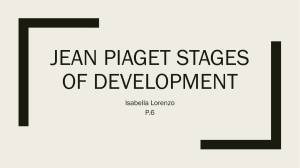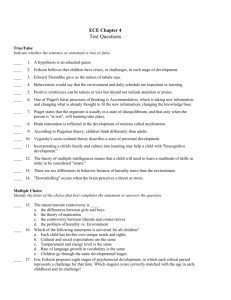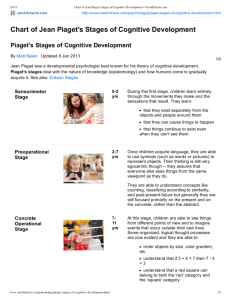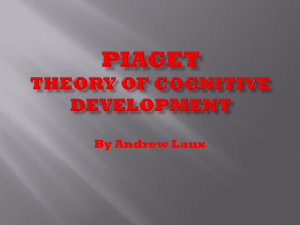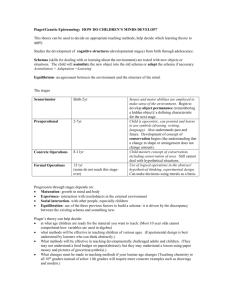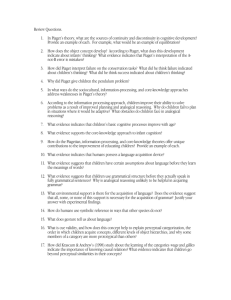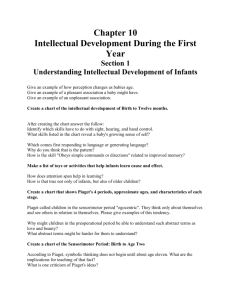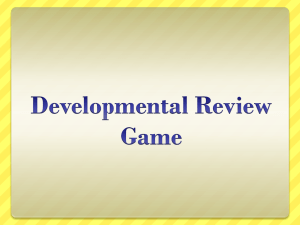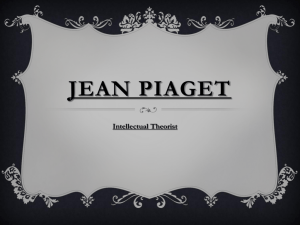Educational Psychology Midterm Exam Questions
advertisement
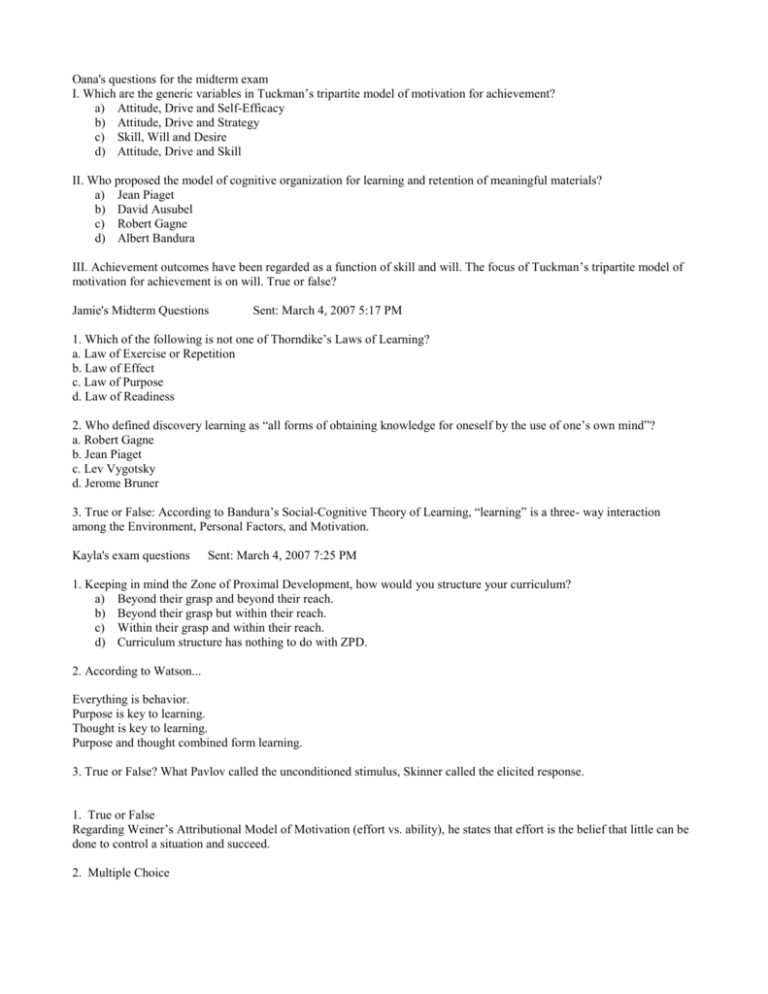
Oana's questions for the midterm exam I. Which are the generic variables in Tuckman’s tripartite model of motivation for achievement? a) Attitude, Drive and Self-Efficacy b) Attitude, Drive and Strategy c) Skill, Will and Desire d) Attitude, Drive and Skill II. Who proposed the model of cognitive organization for learning and retention of meaningful materials? a) Jean Piaget b) David Ausubel c) Robert Gagne d) Albert Bandura III. Achievement outcomes have been regarded as a function of skill and will. The focus of Tuckman’s tripartite model of motivation for achievement is on will. True or false? Jamie's Midterm Questions Sent: March 4, 2007 5:17 PM 1. Which of the following is not one of Thorndike’s Laws of Learning? a. Law of Exercise or Repetition b. Law of Effect c. Law of Purpose d. Law of Readiness 2. Who defined discovery learning as “all forms of obtaining knowledge for oneself by the use of one’s own mind”? a. Robert Gagne b. Jean Piaget c. Lev Vygotsky d. Jerome Bruner 3. True or False: According to Bandura’s Social-Cognitive Theory of Learning, “learning” is a three- way interaction among the Environment, Personal Factors, and Motivation. Kayla's exam questions Sent: March 4, 2007 7:25 PM 1. Keeping in mind the Zone of Proximal Development, how would you structure your curriculum? a) Beyond their grasp and beyond their reach. b) Beyond their grasp but within their reach. c) Within their grasp and within their reach. d) Curriculum structure has nothing to do with ZPD. 2. According to Watson... Everything is behavior. Purpose is key to learning. Thought is key to learning. Purpose and thought combined form learning. 3. True or False? What Pavlov called the unconditioned stimulus, Skinner called the elicited response. 1. True or False Regarding Weiner’s Attributional Model of Motivation (effort vs. ability), he states that effort is the belief that little can be done to control a situation and succeed. 2. Multiple Choice Which of the following is NOT included in Jean Piaget’s constructivism theory? The most critical factor in a child’s cognitive development is interaction with peers. Children are fundamentally different – Ages and Stages. Humans cannot be “given” information, which they immediately understand and use. The most fruitful experience in a child’s education is his or her collaboration with more skilled partners. 3. Multiple Choice Educational Applications of Concept Mapping include: Mapping a learning route. Planning a paper, presentation, exposition, etc. Extracting meaning from laboratory, studio, and/or field studies and experiences. All of the above. Subject: Will's Questions Sent: March 5, 2007 2:25 PM 1)An advantage to discovery learning is it can be used when the learner has no prior information about the subject. True/False 2)A schematic device for representing a set of concept meanings embedded in a framework of propositions is a(n): A) objective matrix B) meaningful map C) concept map D) black box 3)The assumptions that people in an organization dislike work, avoid responsibility, and prefer to be directed would be McGregor’s: A)Theory Y B)Theory X C)Avoidance Theory D)Acceptance Theory 1. Which of the following is not one of the 5 steps of Herbartian learning? Prepare Assumption Generalize Comparison 2. T/F Something that we see visually stays in our short term memory longer than something that is heard. 3. Which of the following is a source of knowledge? a) Folklore and Wisdom b) Empirical Research c) Organized beliefs (myths, philosophy) d) All of the above 1. T F Proponents of Situated Cognition generally believe that learning should be detached, or studied separately, from the context within which it occurs. (FALSE) 2. Which of the following is NOT a stage in Piaget’s “Ages and Stages” theory of development? a) Sensorimotor b) Relational Operations c) Concrete Operations d) Formal Operations ANSWER: b) 3) Under Hebb’s biological-neurological theory of learning: a) when stimuli occur, the nerves cells will cluster together and form assemblies. b) behavioral theories are more closely related to the physical way that learning occurs than cognitive theories are. c) the learner’s “Will” can have a significant effect on how the brain connects nerve bundles. d) the community of lived practices physically moves in the brain to build “cell assemblies.” ANSWER: a) Jessica Pustka True False: 1.According to the Thorndike’s Law of Effect, a response is weakened if it results in pleasure and strengthened if it results in pain. 2.According to Cognitive Information Processing, which is not an example of Pattern Recognition? a. Template matching b. Automaticity c. Prototype d. Feature Analysis 3.In which of Piaget’s Developmental Stages is the child likely to produce a concrete answer that is likely to be wrong. a. Sensorimotor b. Preoperational c. Concrete d. Formal 1. According to Asubel what are four types of learning? a)rote, reception, discovery and meaningful b)rote, discovery, assimilation and meaningful c)rote, reception, discovery and accomodation 2. True or false: According to Bandera's model a student can enter a P.E. class and his behavior will not change from his reading class. 3. In operant conditioning what are the two principles? A) Consequence and reward B) Shaping and chaining C) variation and selection by consequence What is a limited commodity that is shared through all 5 senses? a. ATTENTION “Chunking” would allow a person to remember all of these amounts of information except for d. 11 In Jean Piaget’s developmental stages, the “formal operations” stage occurs between the ages of 5-7. False: Occurs in 12-15 Miguel 1. The three components of learning through modeling by Bandura are: A. Direct, Symbolic, Synthesized B Direct, Transference, Synthesized C. Physical, Emotional, Cultural D. None of the Above Correct Answer: A 2. T/F Hebb believed that learning was a biological-neuropsychological method Correct Answer True 3. Communities of Practice contain three elements which form a triangle they are: A. Mutal Engagement, Joint Enterprise, Shared Repertorie B. Community Partnerships, Collaboration, Shared Resources C. Advisory Commitees, Shared Resources, Cultural Awareness D. All the Above Correct Answer: A
